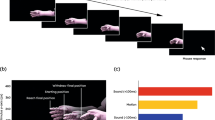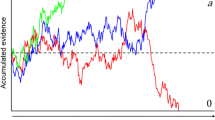Abstract
Human subjects were instructed to intercept with a cursor real and apparent motion targets presented on a computer screen. Targets traveled counterclockwise (CCW) in a circle at one of five angular velocities (180, 300, 420, 480 and 540 deg/s), either smoothly (real motion) or in path-guided apparent motion. Subjects operated a computer mouse and were instructed to intercept targets at the 12 o'clock position; there were no constraints on when to initiate the response, which was a movement from the center of the screen towards and past 12 o'clock. We found the following: (a) for both motion conditions and all target velocities, subjects were late in intercepting the target, especially at higher target velocities; (b) for both motion conditions, the directional variability of the response increased as a linear function of the target velocity; (c) the directional variability of the response was systematically higher for the apparent than the real motion condition; there was no significant interaction between target velocity and target motion type; (d) the response time did not vary significantly with velocity, but was consistently longer for apparent than real motion targets; (e) the movement time was very similar for different target velocities; and (f) the moment of initiation of the interception movement was delayed appreciably at higher target velocities, relative to that dictated for perfect interception at a given target velocity. This delay was greater for the apparent motion target. These results demonstrated the following: (a) for both target motion conditions, interception was not fully predictive but lagged the target in spite of the constant target velocity and the unconstrained time allowed for initiating the interception movement; (b) subjects can intercept an apparent motion target but, compared with real motion, the performance is somewhat degraded overall; (c) the similarities in performance between the two target motion conditions, and the fact that target velocity influenced performance in a similar fashion, suggest that the motor system can access the visual information provided by the moving target; and (d) since movement time was similar for different target velocities, the strategy for interception relied on controlling the moment of initiation of the interception movement. This was successful for low target velocities but became unsuccessful at higher target velocities.
Similar content being viewed by others
References
Caminiti R, Ferraina S, JohnsonPB (1996) The sources of visual information to the primate frontal lobe: a novel role for the superior parietal lobule. Cerebral Cortex, in press
Corbin HH (1942) The perception of grouping and apparent movement in visual depth. Arch Psychol No 273
Exner S (1875) Ueber das Sehen von Beweunen und die Theorie des zusammengesetzten Auges. Sitzungsberichte Akademie Wissenschaft Wien 72:156–190
Fisher RA (1925) The design of experiments. Oliver and Boyd, London
Hecht H, Proffitt DR (1991) Apparent extended body motions in depth. J Exp Psychol Hum Percept Perform 17:1090–1103
Kolers PA (1972) Aspects of motion perception. Pergamon Press, Elmsford, NY
Korte A (1915) Kinematoskopische Untersuchungen. Z Psychol 72:193–296
Kruse W, Port NL, Georgopoulos AP (1994) Motor cortex and interception of moving targets: neuronal population analysis. Soc Neurosci Abstr 20:983
Kruse W, Port NL, Georgopoulos AP (1995) Coding of target motion and hand movement parameters in motor cortex during target interception. Soc Neurosci Abstr 21:2076
Merigan WH, Maunsell JHR (1993) How parallel are the primate visual pathways? Annu Rev Neurosci 16:369–402
Port NL, Pellizzer G, Georgopoulos AP (1992) Movements to apparent and true motion targets. Soc Neurosci Abstr 18:1550
Port NL, Kruse W, Dassonville P, Georgopoulos AP (1994) Motor cortex and interception of moving targets: single cell analysis. Soc Neurosci Abstr 20:982
Poulton EC (1981) Human manual control. In: Handbook of physiology. The nervous system II. American Physiological Society, Bethesda, Md, pp 1337–1389
Saito H, Yukie M, Tanaka K, Hikosaka K, Fukada Y, Iwai E (1986) Integration of direction signals of image motion in the superior temporal sulcus of the macaque monkey. J Neurosci 6:145–157
Sakata H, Shibutani H, Ito Y, Tsurugai K (1986) Parietal cortical neurons responding to rotary movement of visual stimulus in space. Exp Brain Res 61:658–663
Sakata H, Shibutani H, Ito Y, Tsurugai K, Mine S, Kusunoki M (1994) Functional properties of rotation sensitive neurons in the posterior parietal association cortex of the monkey. Exp Brain Res 101:183–202
Schmidt RA (1969) Movement time as a determiner of timing accuracy. J Exp Psychol 79:43–47
Sharp RH, Whiting HTA (1974) Exposure and occluded duration effects in a ballcatching task. J Mot Behav 6:139–147
Shepard RN, Zare SL (1983) Path-guided apparent motion. Science 220:632–634
Shiffrar M, Freyd J (1990) Apparent motion of the human body. Psychol Sci 1:257–264
Snedecor GW, Cochran WG (1989) Statistical methods, (en8th edn). Iowa State University Press, Ames, Iowa
Steinbach MJ (1976) Pursuing the perceptual rather than the retinal stimulus. Vision Res 16:1371–1376
Tanaka K, Saito H (1989) Analysis of motion of the visual field by direction, expansion/contraction, and rotation cells clustered in the dorsal part of the medial superior temporal area of the macaque monkey. J Neurophysiol 62:642–656
Tresilian JR (1994) Approximate information sources and perceptual variables in interceptive timing. J Exp Psychol Hum Percept Perform 20:154–173
Tyldesley DA, Whiting HTA (1975) Operational timing. J Hum Mov Studies 1:172–177
van Donkelaar P, Lee RG, Gellman RS (1992) Control strategies in directing the hand to moving targets. Exp Brain Res 91: 151–161
Wertheimer M (1912) Experimentelle Studien über das Sehen von Bewegung. Z Psychol 61:161–265 (Translated in part in Shipley T (ed) (1961) Classics in psychology. Philosophical Library, New York)
Winer BJ (1971) Statistical principles in experimental design. McGraw-Hill, New York
Author information
Authors and Affiliations
Rights and permissions
About this article
Cite this article
Port, N.L., Pellizzer, G. & Georgopoulos, A.P. Intercepting real and path-guided apparent motion targets. Exp Brain Res 110, 298–307 (1996). https://doi.org/10.1007/BF00228560
Received:
Accepted:
Issue Date:
DOI: https://doi.org/10.1007/BF00228560




